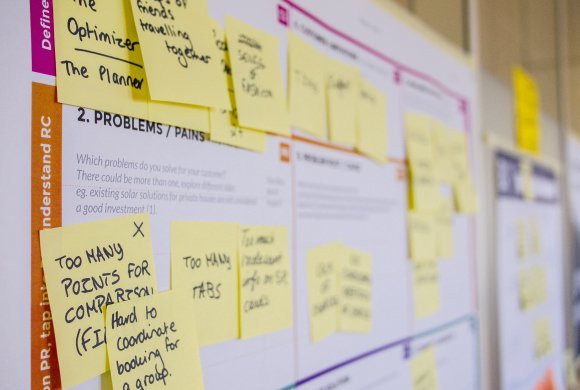Hiring. It’s the universal, never-ending struggle, especially in small business, the struggle to find and keep good talent. I hear this lament from many of my clients, “It never seems to end. We just hire someone and someone else gives their notice. I feel like I spend all my time looking at resumes!” Recently, one of the clients I work with had struggled through several months of being short-staffed due to a number of team members leaving for different reasons. Existing staff were feeling stretched and stressed from having to carry the extra load and morale was low. Management worked feverishly from posting to interview to get all the positions filled. They looked at each other and breathed a sigh of relief. A full staff compliment. That lasted a week before someone else quit, another went on sick leave, and a third asked for a 2 month leave to deal with a family issue. Back to the drawing board.
Why Can’t I Keep People Employed?
Unfortunately, this is not an unusual scenario for small business owners. Keeping good people seems an impossible task. There are a number of reasons for this.
- Job tenure isn’t what it used to be. Whereas 10 years ago it was not unusual for someone to stay at a job for 10-15 years, now the average lifespan of employees, especially Millenials, is 3-5 years.
- Strong competition and lots of options. Other companies are looking for great talent too. If they are willing to offer potential candidates (even those currently working for you) more money or benefits, a better work environment, greater flexibility, you are at risk of losing them.
- High employee expectations. Many job seekers are being more selective and waiting for the job that crosses off all the expectations on their wishlist. Boomers are often looking for work while they are still working and not in a hurry. Millenials are just willing to wait. They would rather go to school or do a “filler” job than take a role that doesn’t give them what they want in a job.
- The labour market is shrinking. Statistics Canada projects that “while the Canadian labour force is projected to continue to increases in size over the next two decades, all projection scenarios still suggest a major slowing in the growth of the population.” There are less people in the market for the jobs available.
- Changing work demographic. Referred to as the “silver tsumani”, a massive number of baby boomers are headed toward retirement over the next 10 years. As they leave, they are being replace by Millenials who have a very different concept and expectation of work. They are less inclined to stay in a job that doesn’t provide them with all the things they want.
- Business owners take hiring short-cuts, which lead them to bad hires and costly turnover. Because of the amount of hiring they are often required to do and to some degree a lack of knowledge in how to hire well managers sometimes do whatever it takes to fill the spaces, circumventing a well-executed hiring process. This leads to hiring people potentially not suited to the job or the team culture, or people who don’t have a clear understanding of the job expectations, and leave when it’s not what they thought it would be.
This may all seem very depressing and lead you to believe you’re doomed to endless turnover. “If I have to look at one more cookie-cutter resume,” moaned one of my clients, “I may throw in the towel!” While these are the current realities, there are some things you can do to mitigate them. Retention may be more difficult now, but it’s not impossible.
The Big Secret
There’s not much you can do to change #1-5 above, but you CAN change what’s addressed in #6. This may come as a surprise, but the secret to keeping people longer, is hiring better. Yes, it takes longer. Yes, it requires more effort and energy. But where has short-cutting your way to a quick or worse, a desperate hire, gotten you? If you do it right, you’ll hire people who are a better fit for your business culture, who will fit right in with your team, who will know exactly what they are signing up for and who are more likely to be loyal to you. It’s not sorcery or some mysterious treasure hunt. It’s mostly common sense and a few new tips you can easily implement. The initial assessment and planning may take some time but once you have a system in place you can execute it quickly whenever you need to hire. So, what do you need to know to hire better and SMARTER?
Pre-hiring
There’s a lot of work that needs to be done before you even write the posting. Starting from a strong place with an understanding of what you really want will give you a foundation to build on. Here are three things to do before you type Indeed.ca into your browser!
- Identify where hiring and retention have tripped you up in the past. Are there any patterns as to why and when people leave? Do you rarely get employees past probation? Do people leave for other companies for similar reasons (i.e. more vacation time, higher salary, greater flexibility)? Are you continuously hiring people with the same types of performance issues? Understanding what hasn’t worked, can be the best way to create a strategy that does.
- Create clarity around the position you are hiring for. What, specifically, do you need this person to do in the job role. If you’re hiring a bookkeeper, maybe anyone will do. But if you need your bookkeeper to be an expert on tax applications, anyone will not do. Create clarity around the “type” of person you want to hire – someone who easily collaborates with others on the team or is a “head-down” introvert who doesn’t like people OK? What kind of person will fit into your company’s culture, the personality of your team? The clearer you can paint this picture, the more likely you’ll know it when you see it.
- Be creative with recruitment. Take a half hour and browse through the ads on Indeed or other popular job posting sites. You’ll quickly notice that most postings are dull, lifeless and don’t give the job seeker any sense of what the company is like. This is your opportunity to brag about your company. Give your posting some flair. Be clear about the kind of person you’re looking for and the kind of company you are. Instead of 10 bullet points regurgitating the job description, how about something like this:
“We are looking for a smart, customer-focused service representative to join our fun, close-knit team. If you are a customer-service hero and have great stories to tell about how you made your customers super satisfied, we’d love to hear them. If you love solving problems, can think on your feet, take responsibility for your decisions and always put the customer first, please apply!”
Selection
This is by far the longest, most difficult part of the hiring process. If you do this well, you’re much more likely to find the best person for the job. Short-cut this part, and you’ll find yourself in trouble over and over again. Here are some tips to make selection more effective.
- Use a multi-layered selection approach. First, eliminate all the candidates who obviously don’t have the skills to do the job. However, be careful that you don’t make assumptions. If an applicant doesn’t know how to use Excel and this is a non-negotiable job requirement, you can move on. If a candidate appears to be “over-qualified”, don’t dismiss them based on assumptions. You can always explore this more later. Second, put some very specific instructions in your posting so that you can quickly weed out those who don’t follow instructions. Ask them to provide a cover letter answering a specific question, or to provide all documents in pdf format. Give them instructions as to how to send their application. The things you ask aren’t as important as the fact that you do. Then, be willing to ruthlessly eliminate anyone who has not followed your instructions. You’ll eliminate a significant number of people, taking down the number of resumes you have to wade through. Finally, create some job-specific “assignments” that you will ask the surviving candidates to complete. For a customer service position you might provide 3 scenarios and ask them to write down how they would deal with those situations. For an admin assistant job, you might provide a formatting assignment. Or maybe you need to know what a candidate’s research skills are. Give them something to research and have them provide their results. This gives you an opportunity to test the most important skills required in the job and weed out people who just can’t be bothered. This approach allows you to be clear with candidates about the dynamics and expectations of the job and helps you to quickly get down to the candidates who really want to work for you.
- Prepare for and use SMART interview techniques. Job seekers these days are pretty savvy and have likely taken workshops or coaching on how to answer the most used interview questions. Unfortunately, the typical questions we ask in interviews generate “canned” and prepared answers. Use unusual questions that make them think on their feet or take them a bit by surprise (What was the last book you read? Did you like it or not? What would you do if you didn’t have to work? What are your top 3 values?). In addition to questions that help you get to know them as people, ask very specific job-oriented questions that help you to get a sense of their competency. Finally, pick up on things in their cover letter or resume that sparked your interest. Ask them why they mentioned their interest in science, which was their favorite job, why they volunteered for the SPCA. This is also a great time to get clarity on any red flags you may have seen in their application. And don’t forget to ask questions that will lead you to a sense of how well they will fit on your team. (What do you think is the most important trait of a great team member? How do you feel when a team member asks for help, especially when you are super busy and working on tight deadlines?).
- Don’t neglect the “closers”. Most people don’t like doing reference checks, but they are important. Because of liability issues, some employers are only providing the bare minimum in reference checks (Yes, Tom worked here from 2012-2014 in a customer service role), but if the employee has left on good terms and made an impact, their references are likely to engage in a deeper conversation. Reference checks are usually to confirm what you already feel about the candidate, but they can sometimes reveal things you may not have discovered in the process. Be savvy in using social media to find out more about your potential employee. Checking a LinkedIn profile, Facebook, or Instagram may generate some more questions for your interview, or provide you with some red flags you need to pay attention to.
- Use a psychometric assessment. There are countless assessments you could use to make your final decision. There are personality tests, behavioural indicators, group dynamic assessments, and each provides information on a different aspect of your candidate’s potential fit. These are especially effective when you’ve narrowed it down to your short-list. At SMART HR we use an assessment called the Style of Influence (SOI) – www.thesoi.com. It has assisted us selecting with pinpoint accuracy not only how effective the person will be in their role and with your team, but also how well they will work with the person who will be their direct supervisor. It’s very cost-effective and has led us to exceptional hires. This can be a fantastic last step to ensure you’ve got the right person.
Hiring and probation
So you’ve gotten this far. You’ve done your due diligence, found the perfect candidate and they’ve accepted the position. What can you do in the first 90 days to ensure they get off to a great start and you can confidently move them into a permanent position?
- Awesome onboarding – Research shows that a person’s first day on the job creates a strong impression and sets the stage for whether the person feels they will be happy to work there. Plan lots of activities for their first day. Keep them moving and busy. There’s nothing worse than starting a new job and being left alone at your desk for hours at a time. Ensure they come to a tidy, organized, well-supplied desk and work area, with everything working properly. Make sure they meet the team, get a tour, and get oriented into their new role. Have someone review their job description with them. Outline what their training process will look like, and get them started on a project right away. If they get engaged in the work immediately they will have a strong connection to the company and will feel quickly comfortable as a contributor. Make sure there is a plan for their first week and month on the job. Let different people in the company help with the onboarding. Assign a “buddy” who checks in with them regularly, has lunch with them, helps them get to know the others on the team. The onboarding process is the often the most poorly-done part of the hiring process. Use this opportunity to WOW your new team member and you’ll generate loyalty, enthusiasm and engagement.
- Create clarity around expectations during probation – Your new employee needs to know from day one what is expected of them. What does success in their role look like after 1 week? 1 month? 2 months and 3 months? Where can they go for help? How will they know if they’re doing a good job? When will you be checking in with them to give feedback on their progress? If this groundwork isn’t set, you’ll hit the 90 day probation with ambiguity and frustration.
- Finally, only move people through to permanent positions if you are extremely confident they are a best fit. Too many managers are afraid to do this or want to wait until they see more from the employee. This can be a big mistake as once they move past probation, it’s more difficult to conduct a termination if they are not a fit. If you see red flags, be honest about whether they can be overcome. Letting it drag on doesn’t do anyone any favours. If not, end the employment and move on. If you’re not sure but want to give them more time, extend their probation rather than move them into a permanent position before you are sure.
I realize this is may seem like a lot of work. And I’ll be honest, it is. But once you develop this system and go through it once or twice, you’ll really get a feeling for how effective it is and it will get easier and take less time. And, you’ll have the benefit of having much stronger, more qualified hires that are more likely to stay with you.
At SMART HR, we’re here to help you with creating your dynamite process and working with you to create awesome hires, reduce your turnover and save you money! Let us know if you have any questions or want to talk about how to make this happen for your company!




